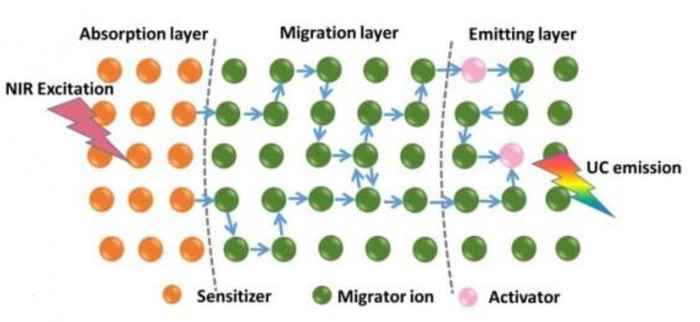Precisely tailoring the dynamics of upconversion luminescence
Dedicated core-shell nanostructures control the migration of upconversion excitation energy
31 January 2018

Upconversion is a process in which one photon is emitted upon absorption of several photons of lower energy. It thus 'jacks' the light from lower to higher frequencies. Typically upconversion materials are doped with lanthanide ions. These are able to shift the near infrared (NIR) light of an economic continuous wave milliwatt laser towards higher, visible frequencies and even into the ultraviolet (UV) spectral region. Potential applications in super resolution spectroscopy, high density data storage, anti-counterfeiting and biological imaging and photo-induced therapy.
Upconversion luminescence dynamics has long been believed to be determined solely by the emitting ions and their interactions with neighbouring sensitizing ions. The current research shows that this does not hold for nanostructures. Zhang, Meijer and co-workers demonstrate that in nanocrystals the luminescence time behaviour is seriously affected by the migration process of the excitation energy.
The research was performed in a cooperation between the HIMS groups of professors Hong Zhang (photonic nanochemistry) and Evert Jan Meijer (computational chemistry), and the group of professors Xianggui Kong and Hong Zhang at Changchun Institute of Optics, Fine Mechanics and Physics (CIOMP), Chinese Academy of Sciences (CAS).
Complementary spectroscopic measurements and theoretical modelling
The researchers unravelled the intimate link between the random nature of the energy migration and the upconversion luminescence time behaviour by means of a complementary approach of advanced spectroscopy and time-resolved Monte Carlo simulation. As model systems they used so-called 'dopant ions spatially separated' (DISS) nanostructures, where activators and sensitizers are located into different spatial regions of a single nanoparticle. The influence of energy migration could be quantitatively depicted by tuning the thickness of the migration layer or by varying the migrator ion dopant concentration in the migration layer.

It was thus established that, as a result of its random nature, the migration of the excitation energy between any two points in the crystal takes more time than what would be expected from a straight point-to-point energy transfer.
Based on this new fundamental insight, the researchers were able to successfully control the upconversion luminescence time behaviour (either the rise or decay process) by tuning the energy migration paths in various specifically designed DISS nanostructures. This result is significant for the application of this sort of materials in super resolution spectroscopy, high density data storage, anti-counterfeiting and biological imaging.

This work was financially supported by the Chinese National Science Foundation, the joint research program between the Academies of Sciences of China (CAS) and the Netherlands (KNAW), the European Union (MSCA-ITN-ETN Action program ISPIC, and COST), the Netherlands Organisation for Scientific Research (NWO, Fund New Chemical Innovation and FOM) and the John van Geuns foundation (Fellowship under auspices of HRSMC).
Reference:
Jing Zuo, Dapeng Sun, Langping Tu, Yanni Wu, Yinghui Cao, Bin Xue, Youlin Zhang, Yulei Chang, Xiaomin Liu, Xianggui Kong, Wybren Jan Buma, Evert Jan Meijer, and Hong Zhang: Precisely Tailoring Upconversion Dynamics via Energy Migration in Core-Shell Nanostructures Angewandte Chemie International Edition, accepted 24 January 2018 DOI: 10.1002/anie.201711606 and 10.1002/ange.201711606